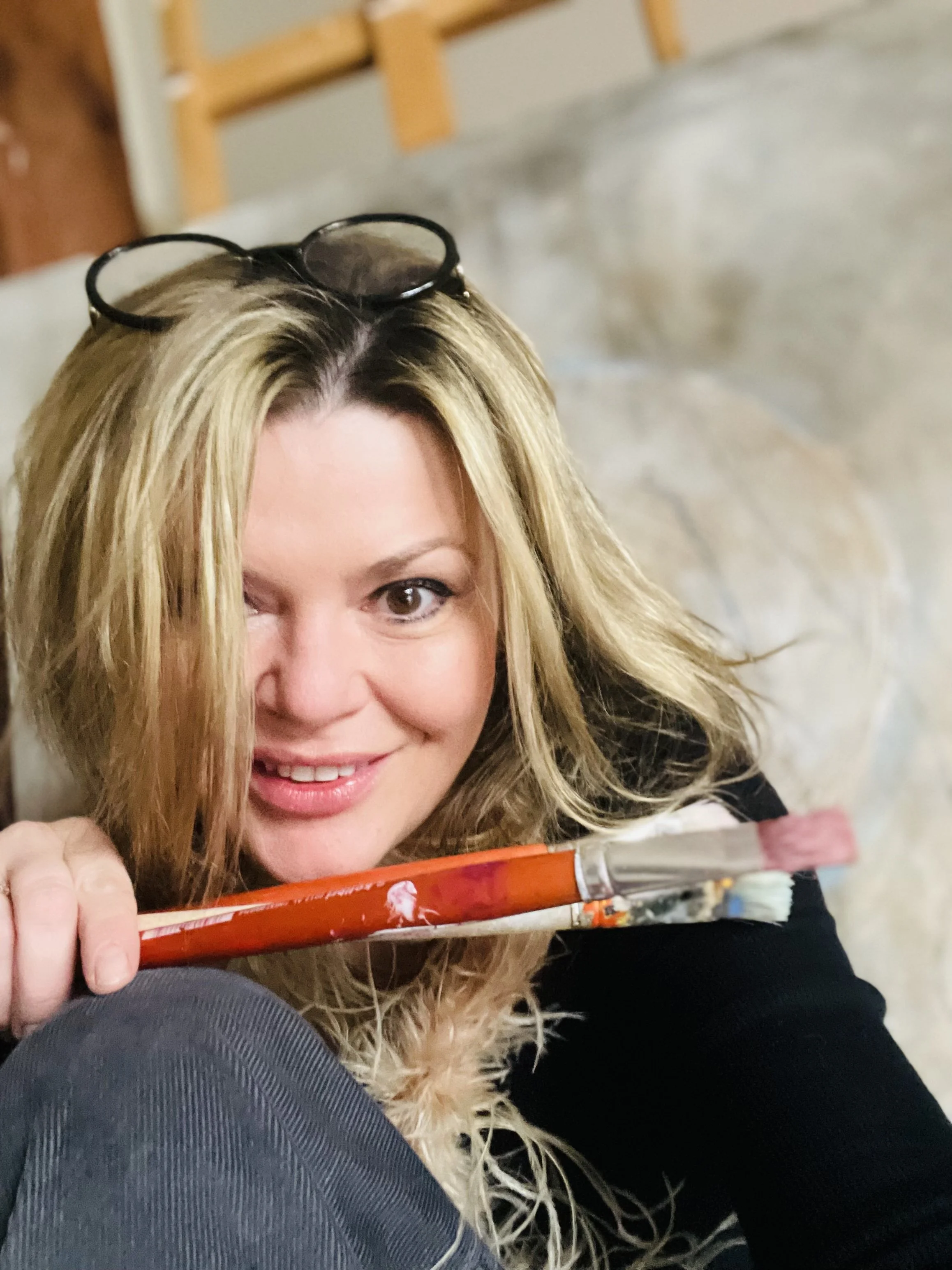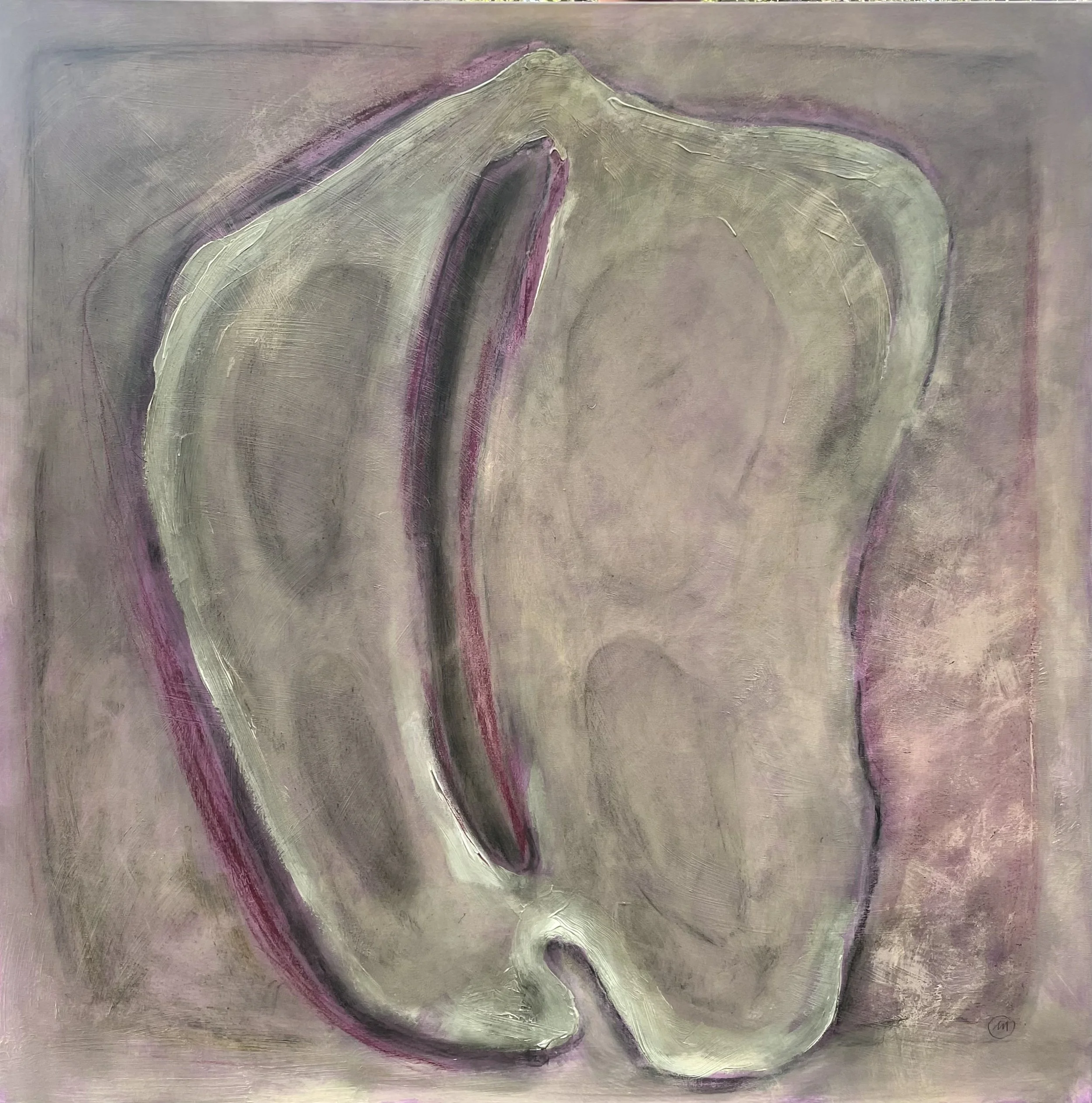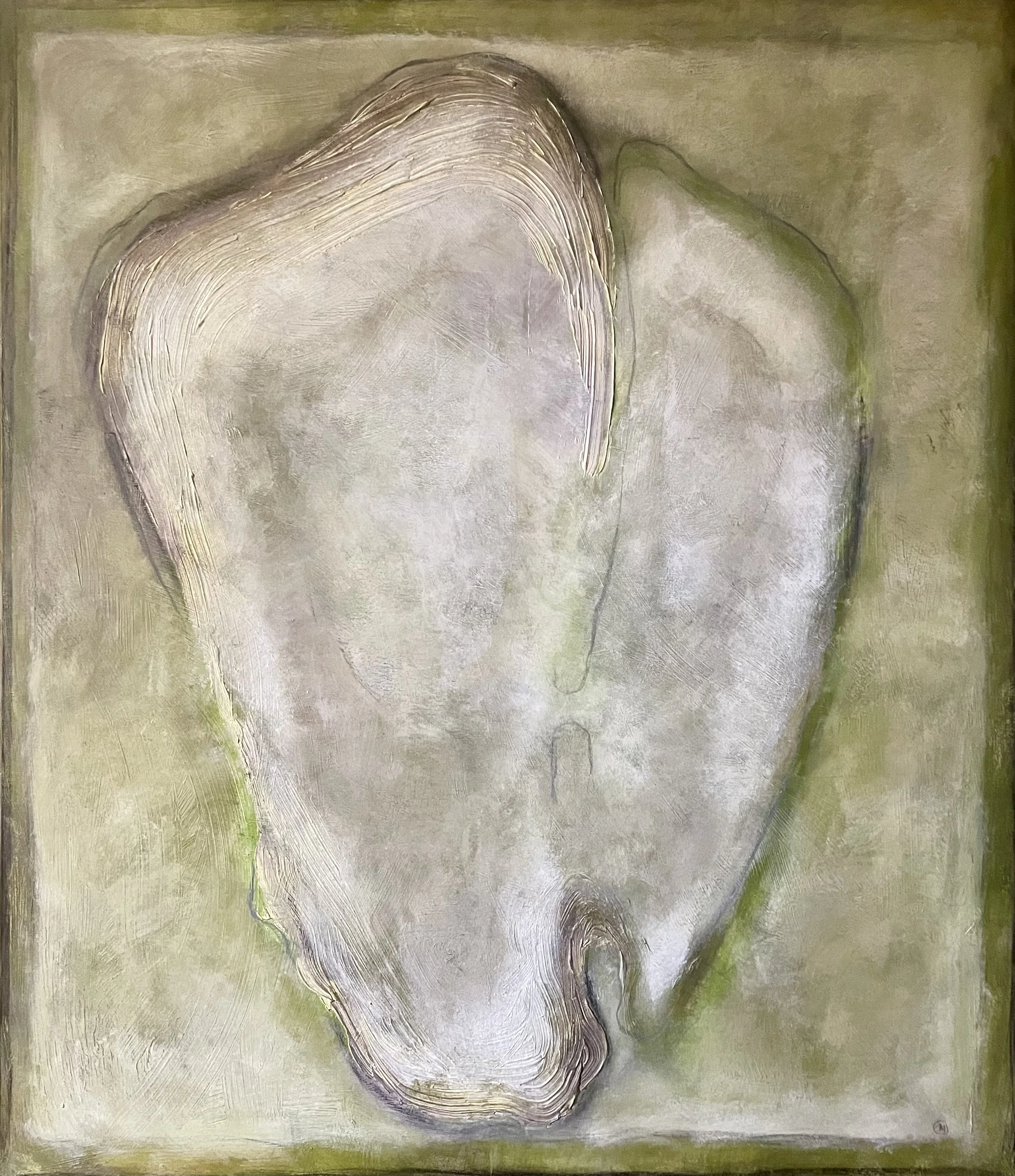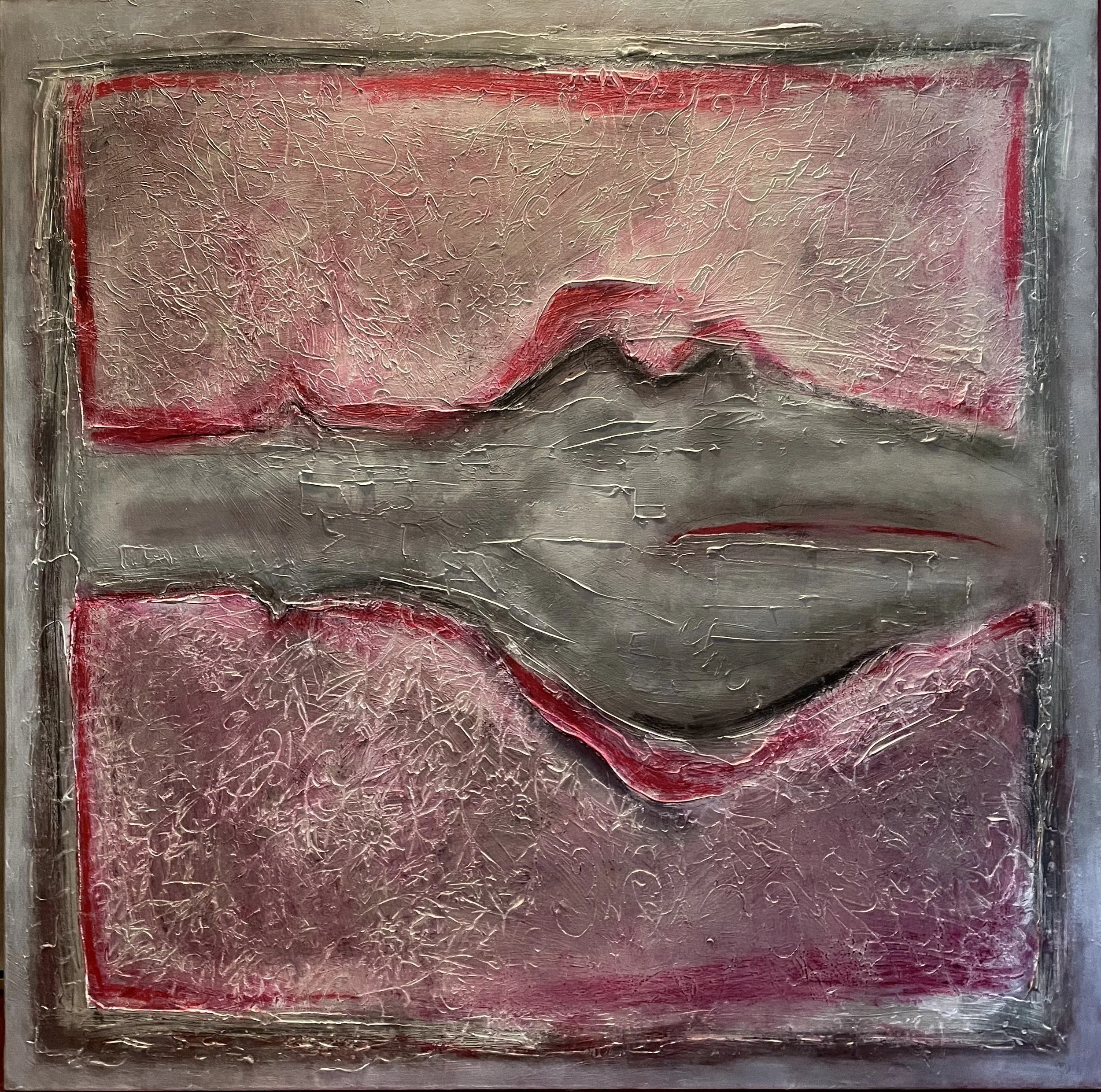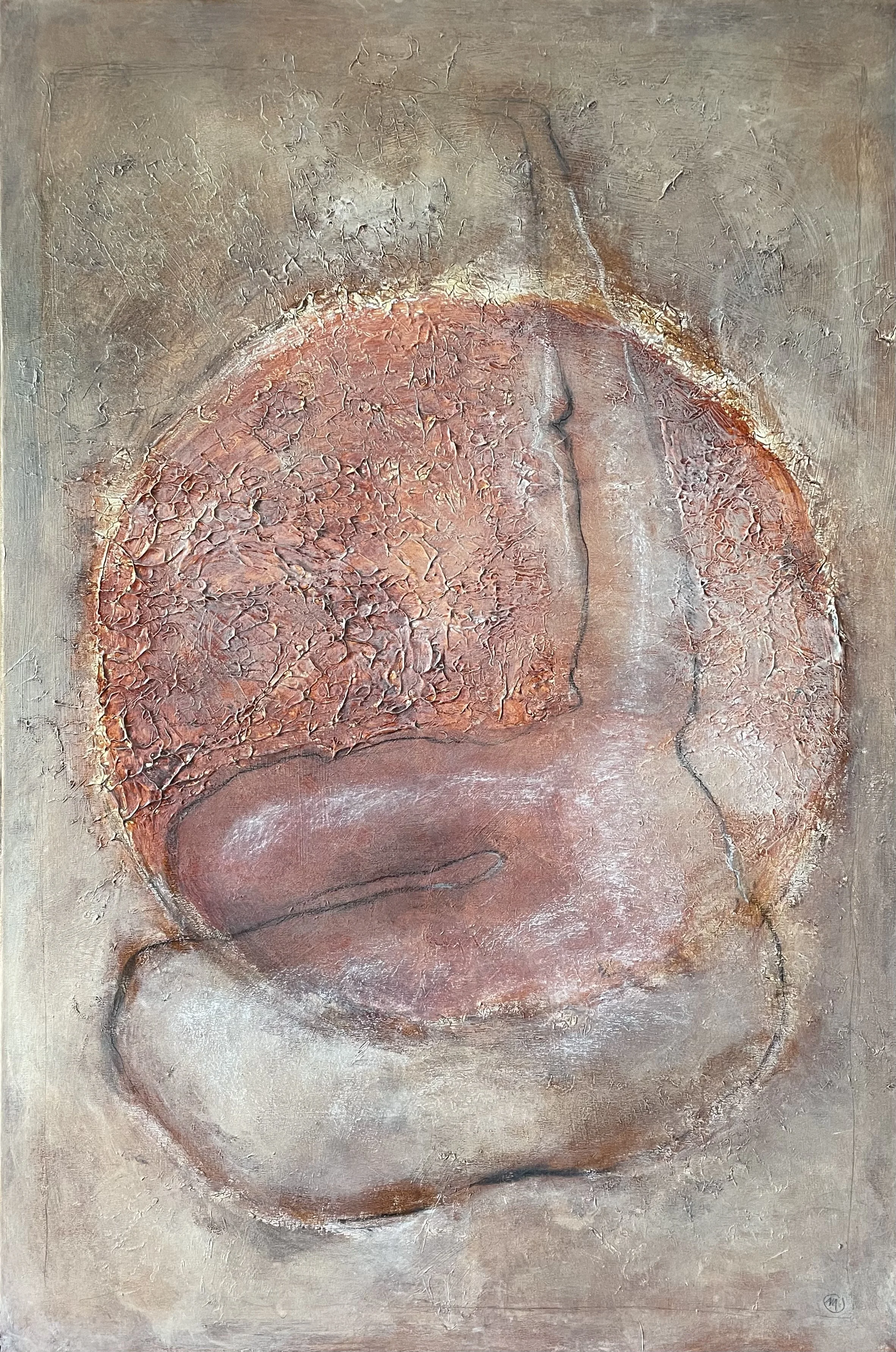Interview with Malina Wieczorek
Biographical note:
Malina Wieczorek studied at the Academy of Fine Arts in Cracow, graduating in 1996 with honors. Diploma in the Interior Design Studio with prof. Barbara Borkowska-Larysz, annex in Graphic Design with prof. Jacek Siwczynski. Painting in the studio of prof. Janusz Tarabula. She has been exhibiting since 1994. Her works are on permanent display in prestigious corporate and private collections around the world.
Artist Statement:
I have been creating female nudes for decades. For me as a painter, women's bodies give a greater palette to ponder about the truth of life. They touch on existential problems that affect us all. I am fascinated by the body reduced to a sign, an abstract form, which gives a huge field of imagination and searching for my own answers to the questions of what the painting really represents.
Women are mothers, lovers, but also ephemeral saints or people following their own paths. Maybe because I am a woman myself, I give myself the right to some deformations and simplifications. Searching for what cannot be seen. It's a bit of an experience on its own. Women have been a source of discussion for centuries - what matters, soul or beauty? What is beauty really? Because everyone sees and understands it differently.
We are all repeating the same story of creation. All we can do is try deeper and deeper to understand who we are. That's what the Madonna series is all about. My Madonnas refer to both classical iconography and identity related to the old local culture. I replaced the halo from classic paintings with a pattern made of folk rollers, sometimes this halo is somewhere on the side, redefining the way it is shown and asking the question what really builds it. One can get the impression that these patterns irritate the body, cut into it and even hurt. Other times they are like a flower meadow around the heroines of the picture. It is this ambiguity and the possibility of self-interpretation, depending on the moment of life, own history, mood in which the recipient finds himself, that is the most interesting.
About the paintings:
Malina Wieczorek has been painting women for several decades. These acts can certainly be included in the so-called of conceptual art. The figures of the women she creates are reflected as if in Venetian mirrors, unaware of the observation to which they have been exposed and, in a sense, condemned. Most often they emerge from the interior of the painting somewhat shyly, half-gesture or half-profile. Similar and different at the same time. Lonely, yet clearly present among us. The artist used to call them acts, and this term can be applied to both the physical and spiritual spheres.
The "Madonnas" series, realized since 2020, refers to the classic iconography and identity related to the culture of the regions. The artist replaces the halo with a pattern made of folk rollers, sometimes this halo is somewhere on the side, redefining the way in which the "sanctity" of women is shown and asking the question, what is it today? Often one can get the impression that it irritates the body, cuts into it, hurting. At other times, it is like a flower meadow around the heroines of the painting. It is this ambiguity and the possibility of self-interpretation, depending on the moment of life, one's own history, the mood of the recipient, that is the most interesting for the artist.
Attempts to read, for example, cuneiform on linguistic principles, often do not bring a satisfactory result. Hence the question, shouldn't we read with "emotions"? Just as it happens in reading and understanding images.
Malina Wieczorek's conceptual painting finds answers to who we are in emotions. Although we call it "painting", Malina actually draws with a brush. These are drawn pictures. Worn backgrounds, always a contour, gray paint and a lot of free space for free associations. The backgrounds on which the shapes appear are usually red, brick red, orange, or gray. A gray outline on a gray background is practically the ideal of imperceptible painting.
There are some contradictions in her work. He uses strong colors but doesn't really want it to be visible. Strong colors are not her ideal. But then again, how can you talk about feelings and emotions without using contrasting colors?
Further analysis is offered by the international art portal - "Malina's paintings raise important questions: in which directions does a modern woman have to go in order to achieve her ideal self? Do hands, feet and legs matter? Do breasts and buttocks count? Can the meaning of the female form survive after stretching and satisfying the whims of the artist?”
The artist herself admits: “I ask myself, when are we women so deeply? Maybe it's courage in constantly asking the most important questions and in uncompromising answers? I think everyone feels it's women's time. These acts show our often hidden, true selves, a range of feelings. And despite the fact that they have been deliberately deformed, they are beautiful. Because it comes from within them, from their strength.
Malina, your artistic journey began at the Academy of Fine Arts in Cracow, where you studied under notable figures like prof. Barbara Borkowska-Larysz and prof. Janusz Tarabula. How did their mentorship shape your approach to conceptual art, particularly in your focus on female nudes and the exploration of existential themes?
I must admit I feel incredibly lucky to have met so many brilliant mentors throughout my life - not only artists but also scientists, inventors, businessmen or linguists, with whom I could and can still talk for hours and dissect theories about the world, soul, and body. I’ve worked in many fields - social marketing, advertising, architecture, and, obviously, painting. I think that already during my studies at the Academy of Fine Arts in Cracow my professors knew I’d go down an unconventional route and they fully embraced and trusted me with my choices. At one point I almost felt like I was completing a personalized course of study.
During my final two years at the Academy I went back and forth between two cities: Cracow, where I studied, and Warsaw, where I worked and received one of the very first awards in advertising. I remember bringing the statuette back to Cracow and the dean giving it to me in front of the entire faculty. Even though I was often an insubordinate student, I could tell my professors were proud of me, which gave me a big confidence boost.
It was already then that I began experimenting with form, material, and the defragmentation and decomposition of objects. I would make my own paint out of wood glue and loose pigments. The effect was incredible, the durability - maybe not so much. Two paintings have survived the test of time though, and I still have them to this day. One of them is the nude “My First Woman”.
Your works often depict women in a state of semi-reveal, capturing them in half-gesture or half-profile. Can you elaborate on the significance of this presentation and how it reflects the duality of presence and absence in the female experience?
It’s really not the body that matters in these paintings, although it is their starting point. It’s important to notice that my models don’t have what’s most important for people, which are heads - they are outside the frame, hidden in arms, turned away. They remain in the real world, saturating the painting with the magic of their non-existence. I don’t think that in doing so, contrary to what some people think, I’m taking away the women’s identities. Instead I reveal these identities through gestures, poses, and other details. I like to think of these paintings as stills from the theatre of life, a theatre we continuously create. They are records of life’s fragments, states of simultaneous being and non-being, or being in two spaces at once.
I think we all strive for beauty, for harmony, also in a transcendental sense. There is a fragment of the Bible that talks about the body being a tent for the soul, maybe that’s what it is. We need to be attentive to the body; it captures moments, one’s emotions. We can spend a long time looking at it and wondering what a person was thinking in a particular moment, what caused their body to produce a particular shape.
The "Madonnas" series juxtaposes classical iconography with local cultural elements, using patterns from folk rollers in place of traditional halos. What inspired this innovative approach, and how do you believe it redefines the sanctity and identity of women in contemporary art?
A woman takes on many roles throughout her life - she is a mother, lover, ephemeral saint, or individual breaking out of stereotypes and conventions. My abstract nudes inspire reflection on the truth of our own self, both female and human. After all, we are all repeating the same story of creation; all we can do is try to more deeply understand who we are. That’s what the “Madonna” cycle is about. My Madonnas allude to both classical iconography and identities tied to old local cultures. I replaced the typically classical halo with a pattern made of folk rollers. Sometimes this halo is somewhere on the side, redefining its own portrayal and asking the question of what it’s really made of. You can almost feel as if the patterns irritate the body, jam into it, even wound it; other times they look like flower fields surrounding the model. When used to make patterns on the walls of rural homes, rollers can represent repetitiveness, also an integral part of life. It is this ambiguity and potential for personalized interpretation, influenced by one’s age, life story or even mood that I find most interesting.
Your statement mentions the exploration of beauty and the soul through the lens of the female form. How do you navigate the tension between the physical and spiritual in your paintings, and what message do you hope to convey to your audience through this dichotomy?
The human body is seen as an artistic theme, source of expression and a carrier of meaning and emotion. In a metaphorical sense I relate nudity to metaphysics and spirituality. To me, as a painter, both male and female bodies can inspire a great deal of reflection about life’s truths. They represent existential topics, important for us all. I am fascinated by the body being reduced to a sign, an abstract form, which leaves space for imagination and encourages one to seek individual interpretation. In this way, the work is also part of a story, a sign of a given time; we don’t control it entirely, we can only read it intuitively. By not being tied down, the work retains its inherent freedom. Maybe because I myself am a woman, a person, I allow myself certain deformations, simplifications; looking for what cannot be seen. It’s almost like an experiment on myself. I use these works to encourage the search for answers to the most difficult questions, to remain a non-conformist against my own self. I find this very important, especially in the times we live in.
In your art, strong colors are used, yet you strive for them not to be overtly visible. This paradox is intriguing. Could you discuss your philosophy behind this technique and how it aligns with your broader artistic vision?
It’s said that a gray contour on a gray background is the epitome of imperceivable painting. Maybe then it is not the color that matters, but something else? I have days when I don’t use any reds and others when I rely on them entirely. It depends on the day, it’s almost like a balancing of energy. My works are always multi-layered; their colors change depending on the light. As a result the person seeing it is, in a way, presented with several works.
It’s also important to add that when I paint there is a moment when a painting takes control over me. I enter a meditation-like state, a trance. I talk with the painting and it talks with me; we become unified. Sometimes I leave a painting alone for a week, two, to then look at it with fresh eyes. I paint quickly, while also not rushing. Art needs time. And then suddenly I realize - this is it.
Your works are said to reflect women as mothers, lovers, saints, and individuals on their own paths. How does your personal identity as a woman influence these portrayals, and in what ways do you believe your art challenges or reinforces societal perceptions of femininity?
We’ve definitely arrived at the age of women, at the age of appreciating the female energy that each of us carries. In art we’ve been seeing women depicted as mothers, wives, saints, or sexual beings. This multiplicity of roles and meanings reflects the experience of each woman throughout her life. It’s great to see, this variety. It also encourages discussion, which is incredibly important in today’s uncertain, dynamic times and which I try not to shy away from. I want to use my works to stimulate thoughtful dialogue about womanhood. I’m eager to explore how many directions a modern woman has to go in to find her ideal self.
You mention that your art seeks answers to existential questions through emotions rather than linguistic principles. How do you believe this approach impacts the viewer’s engagement with your work, and what role does abstraction play in this emotional resonance?
All this is reflected in the “Signs” cycle. The cycle came from my reflections on the often unsuccessful attempts at reading cuneiform and hieroglyphics using linguistic principles. So from there I asked the question: why not read using emotion, the way we do when looking at paintings? Naturally my female nudes are part of “Signs”. They reverberate like music, similarly to runes which denote sounds, not letters. This also brings to mind my “Mouths and Other Imponderables” cycle, which focuses on the importance of detail through the example of lips, dozens of iterations of them. Or “The Hatching of Identity”, in which I explore the emergence of our awareness of the true, human, multidimensional, female self. And we can ask: what is the woman really like? To me she unites spaces, she’s both strong and delicate, tough and open to life. Each of these facets deserves attention, teaches us something and inspires. I know that women possess great power to overcome difficulties. But let’s not forget that on the other end of the spectrum we have the incredibly important male energy. We carry many energies and qualities within us and only by uniting them can we achieve harmony.
The international art portal has posed questions about the modern woman's journey towards her ideal self, using your work as a point of reference. How do you perceive the evolving role of women in contemporary society, and in what ways does your art contribute to this discourse?
In contemporary visual culture, in which we’re constantly bombarded with images of “perfect” bodies, natural aspects of life, such as imperfections that appear with age, have become almost foreign and too shameful to be revealed and discussed openly. It can seem like we’re forgetting the essence of our existence and at all costs attempt to defy the effects of time. In my work, whilst caring about the beauty of the body, I prioritize human existence, the immortality of the soul, which after all isn’t trapped in a body and doesn’t perceive it as something to be perfected, but as a shelter, an outlet in which it feels safe. Our being is constantly developing through the many stages of our life, and the nurture of personal values allows us to love ourselves and thereby treat others with the same love.
I often feel like I exist non-linearly or within many time frames, which causes my mind to return to old paintings and paint them anew. An art curator once said that these works ask many existential questions that not everyone is willing to answer. But it depends on us whether we answer them, whether we read poetry or discuss important topics, whether we seek answers to century-old questions. This doesn’t have to be painful, it can be highly enjoyable. Like everything around us, such paintings can be merely a decoration or an inspiration for personal growth.
Your paintings are known for their worn backgrounds and ample space for free associations, often described as drawn pictures with a brush. Can you delve into your creative process and how these stylistic choices enhance the narrative and emotional depth of your pieces?
That’s how a well-known Warsaw art critic Bogusław Deptuła described my painting style many years ago. Indeed my style contains an element of drawing, I often finalize paintings with crayons or pencils. Often this comes from aesthetic need, but most of the time it’s the only way of conveying the dynamism of a message or its fleetingness. It’s a search for the ideal form of artistic expression but also my individual way of creating, correspondent with my temperament and personality. In my work I also constantly wonder whether the deformations and defragmentations I portray, which in real life dictate our paths, represent ugliness or beauty. Maybe without them there would be no progress? The nudes I paint ask several things: when are we most beautiful, most full, what is life for, what has it all been created and who controls it? My work is nothing but a return to the beginnings of existence.
Having exhibited globally from Warsaw to Venice and New York, how do you adapt your thematic explorations of femininity and existentialism to resonate with diverse cultural audiences, and what feedback or interactions have most profoundly influenced your work?
The abstract nudes concern the body and soul. They depict naked silhouettes, but not everyone sees that at first, they often interpret the paintings according to their own schemas. To me, they show the depth of female nature and personality. They uncover the often hidden, true selves and the variety of emotion often unavailable to outsiders. What I hope for the viewer to take away from these silhouettes are, above all, the emotion, both those of the models as well as their own. The paintings are stories about each of us, our power, love, sometimes sacrifice, about protecting the ones we love. It’s natural that in different parts of the world, with the influence of different cultures, we crave different visuals and understand things differently. We will never be inspired by the same things. I see this from the curatorial choices - different works are shown in the USA, Europe or Asia. Art that is meant to stimulate deep reflection about who women are, who people are at their most fundamental level, should always be respectful of a particular culture and, above all, the human being. Only then can it effectively inspire worthwhile discussion and an attempt at a full understanding of life.
https://mybio.art/malina-wieczorek/
https://www.instagram.com/malinawieczorekart/


